£3.4M in funding secured for Digital Manufacturing Center at heart of UK motorsport
3D Printing and ABS Recycling: Assessing Virgin and Re-used Filament
In the recently published ‘Investigation of closed loop manufacturing with Acrylonitrile Butadiene Styrene (ABS) over multiple generations using Additive Manufacturing,’ authors Mazher Iqbal Mohammed, Daniel Wilson, Eli Gomez-Kervin, Bin Tang, and Jinfeng Wang explore the impacts of FFF 3D printing on acrylonitrile butadiene styrene (ABS) during multiple recycling processes.
As 3D printing increases in popularity, so does the amount of discarded plastic. And while PLA is biodegradable, ABS is a typical plastic that is not—presenting environmental issues. In this study, the researchers hoped to explore FFF systems in regard to their low power consumption which may lend themselves to a path of greater manufacturing sustainability.
The researchers began using virgin ABS, put through two successive closed-loop filament extrusion and 3D printing phases. In this study they used 100 percent recycled 3D printed ABS, made into filament for re-use—allowing them to investigate parameters and potential for defects along the way.
“Studies have previously reported that changes in melt flow index and mechanical properties occur with ABS after recycling using injection and cast-molding,” stated the researchers. “However, to our best knowledge, no study has examined the influence of multiple closed-loop recycling phases using AM, where the grade of ABS and the thermal process regimes differ from manufacturing by molding processes.”
Virgin ABS pellets were extruded as filament and then 3D printed into parts. The researchers made sure to use plastic from one source only to make sure any differences would be directly comparable. Granules were produced in a uniform size, separated with a sieve with a mesh size of 5 mm.
“To determine the average pellet/granule size, 20 ABS pellets or granules were randomly collected from the source batch and their longest lengths were measured and averaged,” stated the researchers.
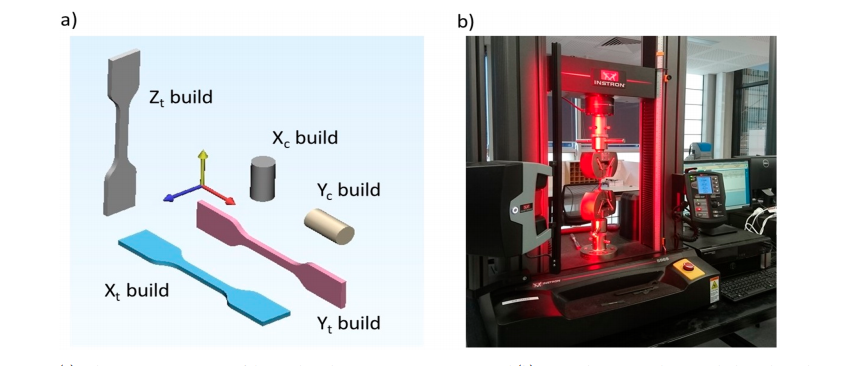
(a) Relative print orientations of the tensile and compression test coupons and (b) universal testing machine on which mechanical tests were performed.
While the study centered around the use of virgin ABS, the research team also experimented with one-time, two-time recycled ABS, as well as samples of 90, 80, 70, 60, 50, 40, 30, 20, and 10% virgin ABS. They assessed extrusion flow rate, 3D printing and characterization, polymer analysis, and mechanical property characterization.
In some cases, ‘nonuniformity of granules’ causes blockages, as well as ‘pinning’ because of sharp edges. The researchers tried agitating granules during extrusion to keep filament flowing correctly. Ultimately, the research team found that the FFF 3D printer performed very well with recycled ABS, and over multiple recycling generations too. They deemed the process successful and one that could indeed serve as a valid method of manufacturing with ‘several generations of use.’
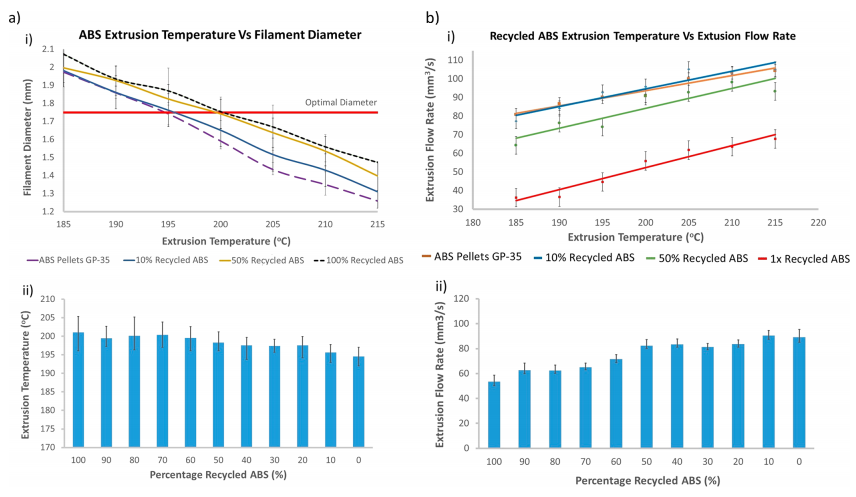
(a) (i) A graph depicting the change in extruded filament diameter for changes in extrusion temperature; for clarity, only results for virgin,10% recycled, 50% recycled, and 100% recycled ABS are illustrated. (a) (ii) Temperature differences when extruding a respective ABS blend relative to obtain a filament diameter of 1.75 mm. (b) (i) Extrusion flow rate for various ABS blends comprising varying percentages of recycled to virgin material; for clarity, only results for virgin, 10% recycled, 50% recycled, and 100% recycled ABS are illustrated. (b) (ii) Extrusion flow rate for the various ABS blends when forming filaments with a diameter of 1.75 mm.
“Arguably, FFF has currently had its greatest commercial success in production of concept prototype devices by design companies or in the manufacturing of ornamental items such as toys and models, which generally have no strict mechanical strength requirements. Therefore, we believe that the use of recycled ABS of either one-time or two-times recycled variants could feasibly replace virgin polymer filaments in such applications, as the measured decline in mechanical strength would not impact the function of the end parts or prototypes,” concluded the researchers.
“FFF holds considerable potential for sustainable management of ABS plastics through its reintroduction into wider industrial manufacturing, potentially creating value from what is otherwise a growing burden to resource-recovery sites and landfill.”
ABS is one of the most popular 3D printing materials, for users on every level whether they are creating new materials and composites, refining issues with adhesion, or even making workstations. What do you think of this news? Let us know your thoughts! Join the discussion of this and other 3D printing topics at 3DPrintBoard.com.

Comparison in compressive stress for compression samples 3D printed using (a) virgin, (b) one-time recycled, and (c) two-times recycled ABS. (d) Summary of the compressive strain for the various ABS samples printed in the two spatial orientations. (e) Summary table of results for all compression test samples.
[Source / Images: ‘Investigation of closed loop manufacturing with Acrylonitrile Butadiene Styrene (ABS) over multiple generations using Additive Manufacturing’]
The post 3D Printing and ABS Recycling: Assessing Virgin and Re-used Filament appeared first on 3DPrint.com | The Voice of 3D Printing / Additive Manufacturing.
2019 Industrial 3D Printing Buying Guide
Industrial 3D printers are systems that are used for manufacturing. These systems are generally costly and offer high throughput and yield. They often require a lot of ancillary equipment, training, and space to operate. Generally most users will have desktop 3D printers while only a few will turn to industrial systems.
There is no best 3D printer. There are many different models and technologies of printers and each has their own advantages. Depending on your situation, throughput and yield several systems could work well for you. Depending on the part quality and part size one printer may be overkill while another may not be what you need. The purpose of this document is, therefore, to show you a number of options that you can consider when buying an industrial 3D printing system. The printers listed have track records that are positive and I’ve received positive comments on these systems through interviews and research. People I know have told me that these systems are worthwhile and that they would recommend them and buy (or lease) more of them should they need more capacity. This list is not exhaustive but it should be a good starting point for someone orienting themselves on a high-grade manufacturing system.
- Standalone Systems would not require HVAC or other complicated installations. These are high-grade printers for use by businesses. They may, depending on the application, require a water jet or other post finishing station.
- High-temperature printers are capable of processing materials above 400 C and can print ultra high performance polymers such as members of the PEAK family. This is an emerging category that is growing quickly. From relatively inexpensive systems ($5000-100,000) users can obtain high performance end use parts. HEPA and carbon filtration and a highly automated print process should help these machines print reliably especially with difficult to process materials such as PEEK. Ideally directed airflow or precision heating and cooling can improve print results. Medium Format 3D printers are those that are not especially high yield but can be suited to making large parts. These types of printers are best suited for outdoor advertising, large molds and such applications.
- The two categories “For the Large-Scale Manufacturing of Fine and Highly Detailed Items” and “For the Large-Scale Manufacturing of Tough End-Use Parts” may seem a bit silly but in my experience, this delineates mayor differences in use cases. If you need a B side tough part especially if it is large-sized, then FDM will probably be the technology of choice while small and detailed parts will lead you to a different system and DLP/SLA. Heads up comparisons between SLA and FDM are often quite silly for many applications.
Standalone Systems
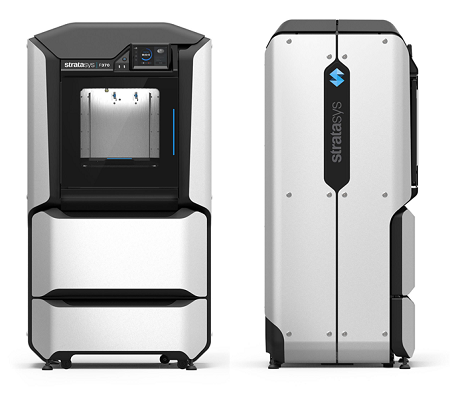
Stratasys F. Stratasys has a number of entry-level systems ranging from the 120 to the F170, F270 and F370. They all work well and give good reliability and repeatability for their price points. You’re going to be more limited in materials than open 3D printers but it will work all the time.
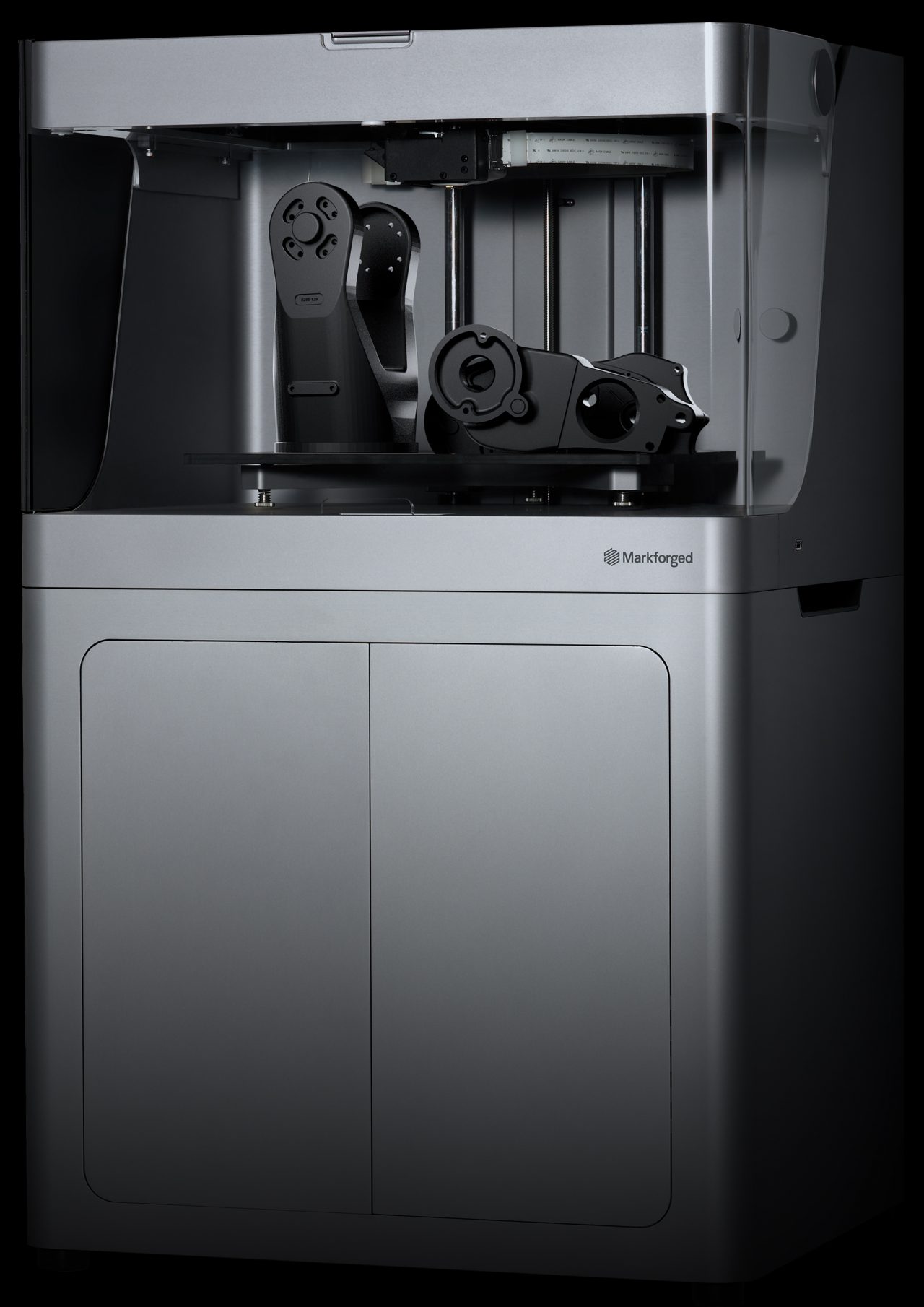 . Markforged’s software is by far the best in the industry which makes running one of these or a fleet a breeze. The $69,000 Onyx lets you 3D print with continuous carbon fiber which gives parts very high stiffness and strength when compared with other systems.
. Markforged’s software is by far the best in the industry which makes running one of these or a fleet a breeze. The $69,000 Onyx lets you 3D print with continuous carbon fiber which gives parts very high stiffness and strength when compared with other systems.
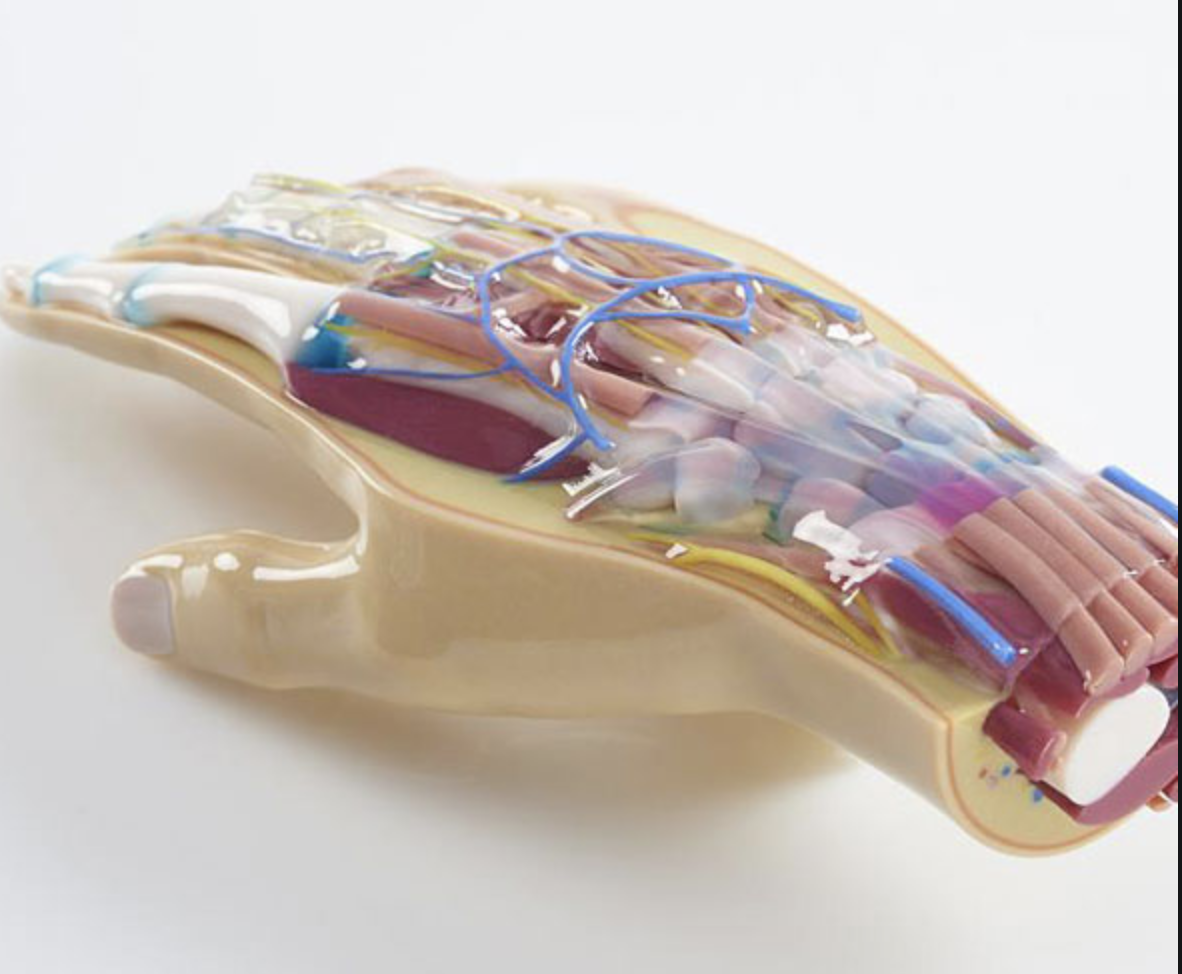
Stratasys J750. The capabilities of the Stratasys J750 are unique. Colors, gradients and unique materials make this a great option for those who need high-quality color 3D prints for display in house. Material is expensive and not as tough as other materials but if looks are a key driver then these parts are killer.

3ntr A2V4. 3ntr’s systems aren’t pretty but the printers are built like a tank. Heavy-duty everything they’re monuments to over-engineering and get accolades from manufacturing people. The A2V4 is not meant for high-temperature materials but optimized for ABS and Nylon. This is a unit built for the factory floor.
The Best Systems for High-Temperature Materials

There is also a special Vshaper Med version of the 270.
Vshaper 270. The Vshaper 270 has a good track record and is a dependable system at an affordable price. The approximately $19,000 system is comparatively easy to use with a small form factor and good performance in PEEK and PEI.
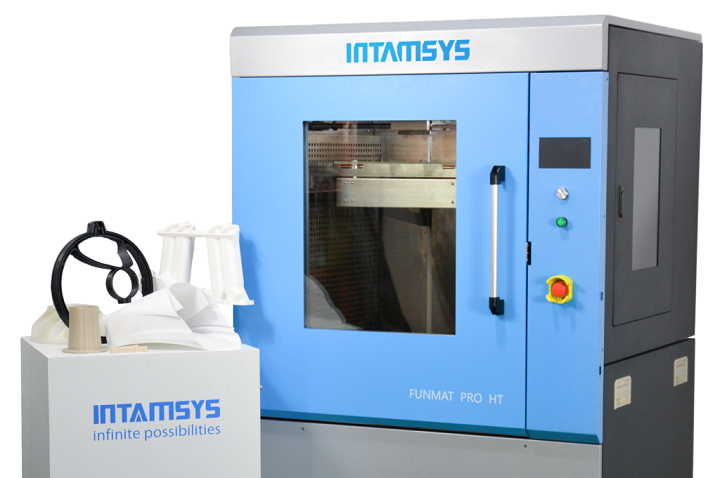
Intamsys Funmat Pro HT. The Intamsys Funmat Pro HT is a 450 x 450 x 600 mm build volume printer that packs a lot of value in its $55,000 box. You should definitely look at this system if 3D printing PEI (Ultem) is of high importance to you.
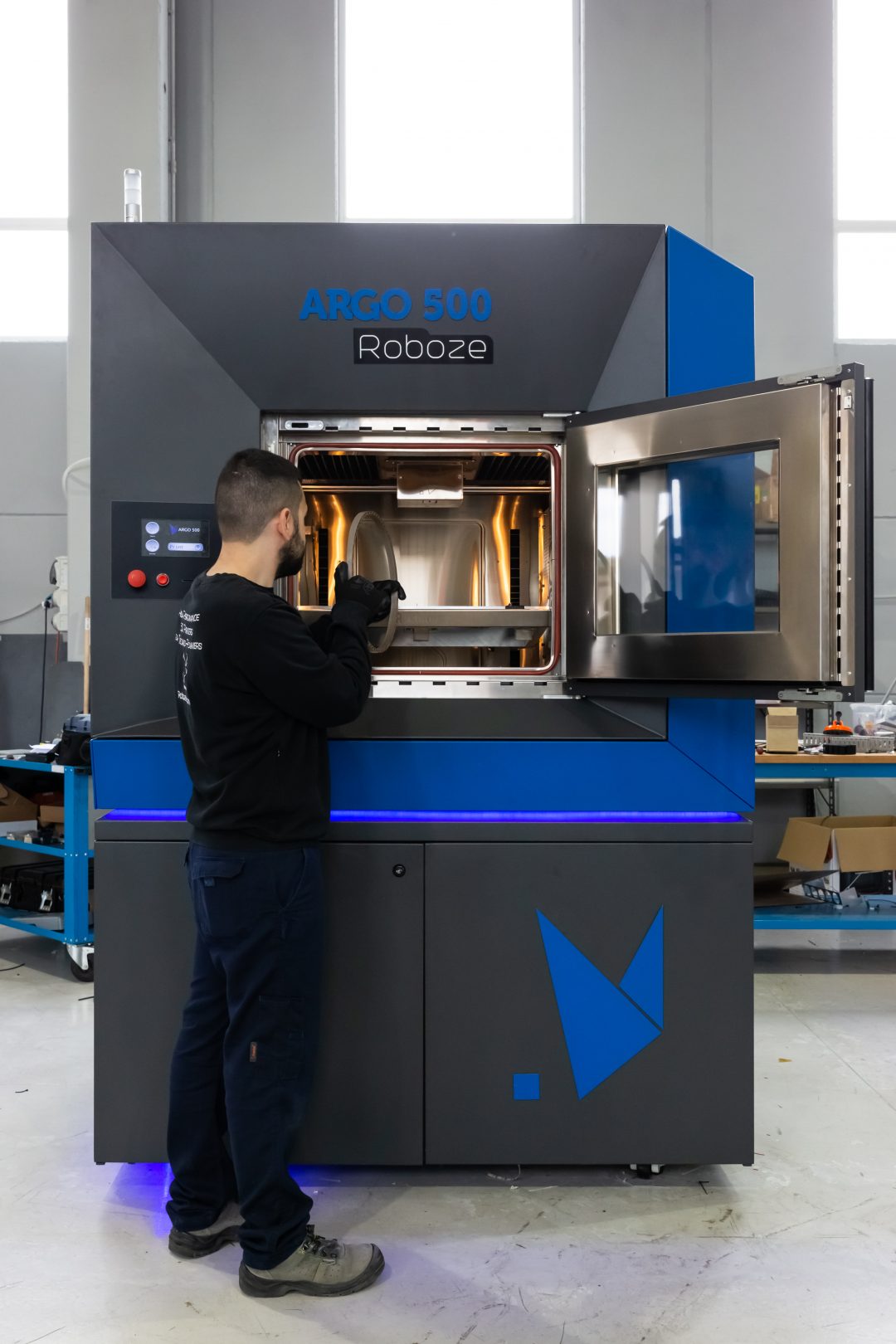
Roboze Argo. Roboze’s Argo is their production 3D printer and is a real step up in build quality and reliability. Nozzle temperatures of 550 C and a vacuum bed make this a versatile workhorse.
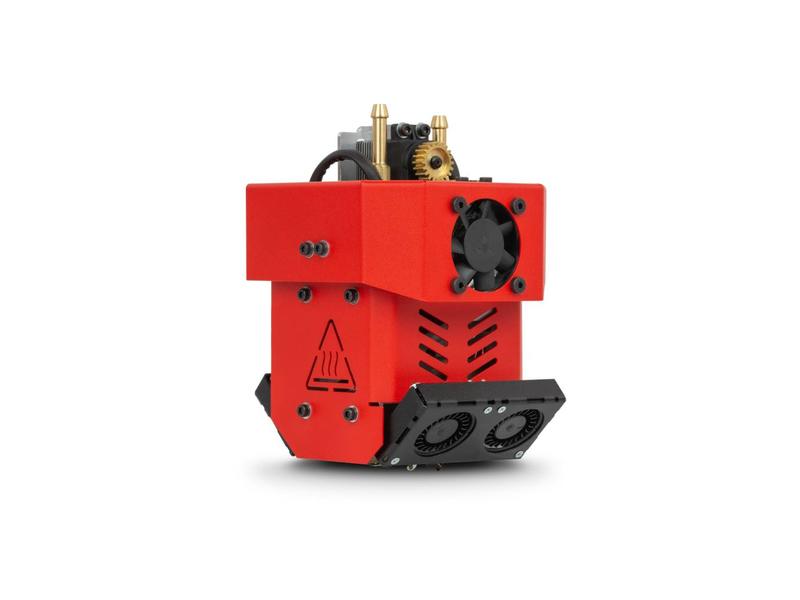
The 3DGence Max module is specifically intended for PEEK. Another module is optmized for PC and yet another for more prosaic materials such as ABS and PET.
3DGence Industry F340. The 3DGence Industry F340 has interchangeable nozzles as well as onboard air filtration. This is a very well built $20,000 high-temperature system. The company is expanding its arsenal through selling specialized hot-ends and modules for particular applications.
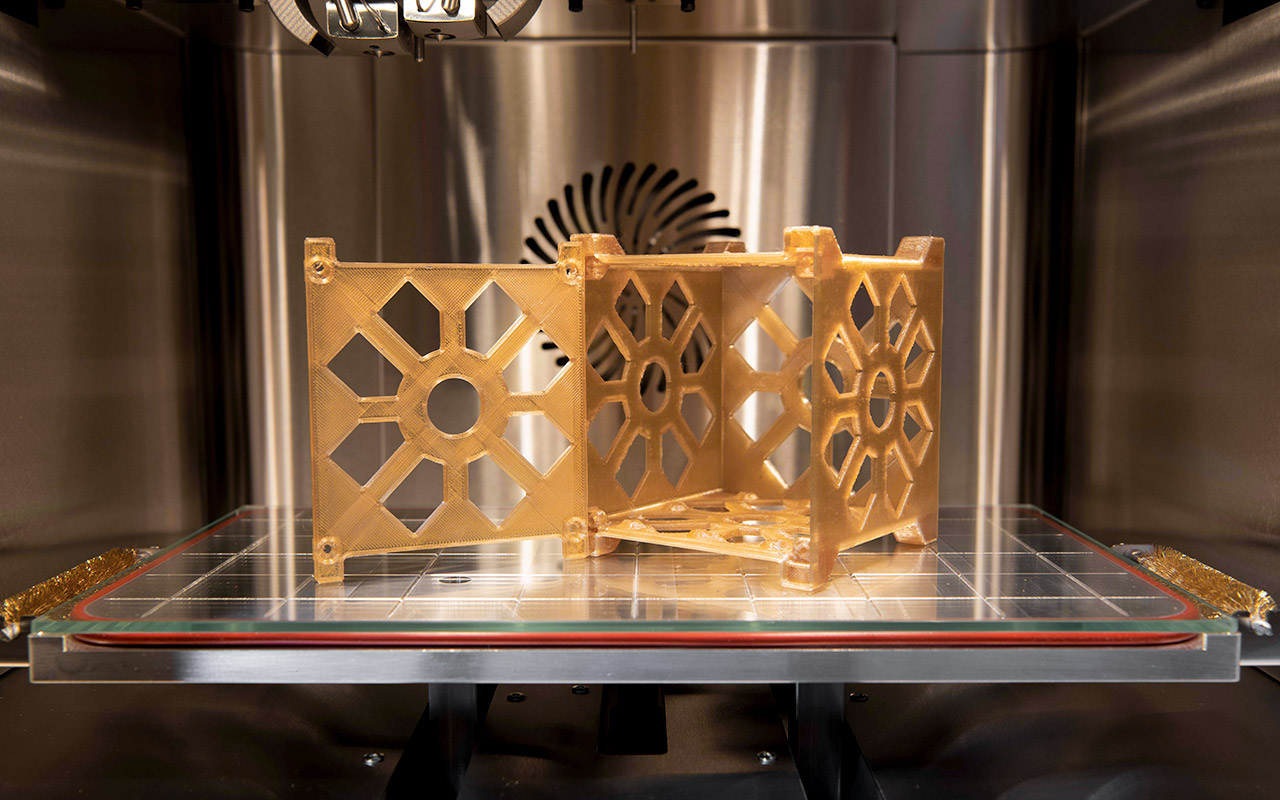
A PEKK part being printed on a Minifactory Ultra.
Minifactory Ultra. I’m a huge fan of Minifactory and also of their Minifactory Ultra machine. The company has a 250 C build chamber and is qualifying parts for its machines. The features that they have on board are all useful on this well engineered carbon filtered, vacuum bed machine with servo motors.
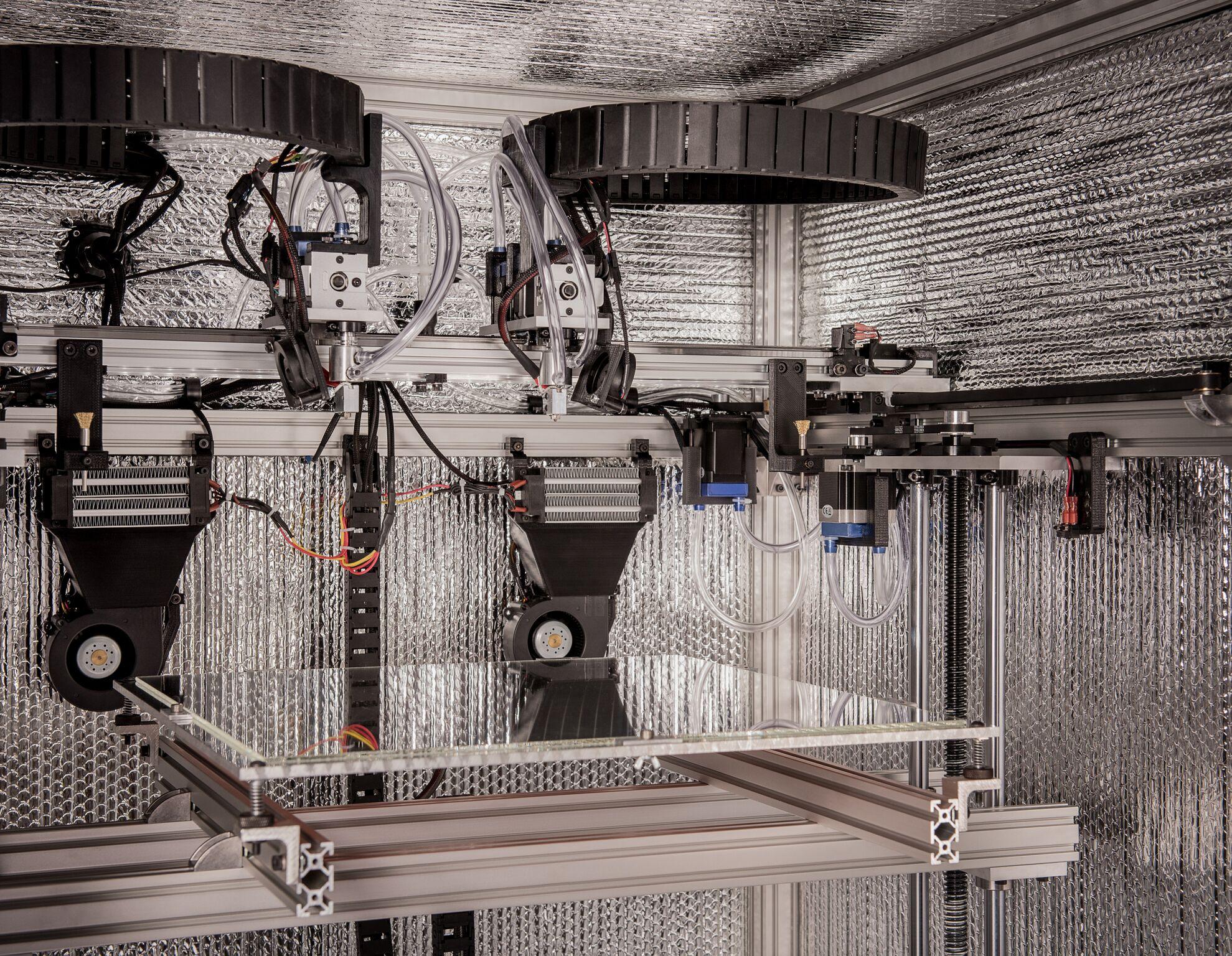
A look inside the AON3D Build Chamber.
AON3D M2. The AON3D M2 is a dual independent tool head system that has liquid cooling on steppers and toolheads for around $30,000.
For the Large-Scale Manufacturing of Fine and Highly Detailed Items

First Available in 2002 the Perfactory has made more end-use parts than any other printer.
EnvisionTEC Perfactory. The EnvisionTEC systems have long been the standard in the manufacturing of in-the-ear hearing aids. Other versions of the same DLP systems are amongst the most productive in jewellery making millions of parts. The Perfactory is an old model but one that is tried and true with a long service life and many versions customized to particular applications.

A Dashboard sized part made on a 950.
3DSystems Pro X 950. 3D Systems Pro X 950 lets you build parts up to 150 CM long. If you need large detailed molds or have high yield requirements in parts such as hearing aids then this huge system is something you need to look at.
For the Large-Scale Manufacturing of Tough End-Use Parts
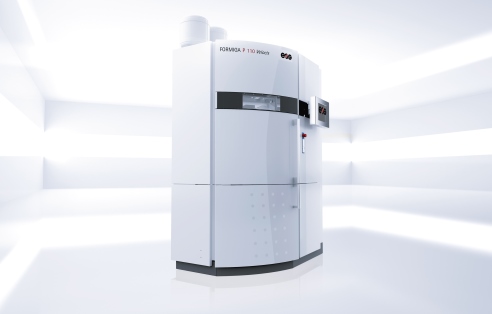
In some markets, you can now lease a p110 for a very attractive amount indeed.
EOS Formiga P110. The Formiga P110 is a productive entry-level selective laser sintering system (powder bed fusion) with high detail, repeatability and quality. If you need several thousand of something this would be my go-to choice.
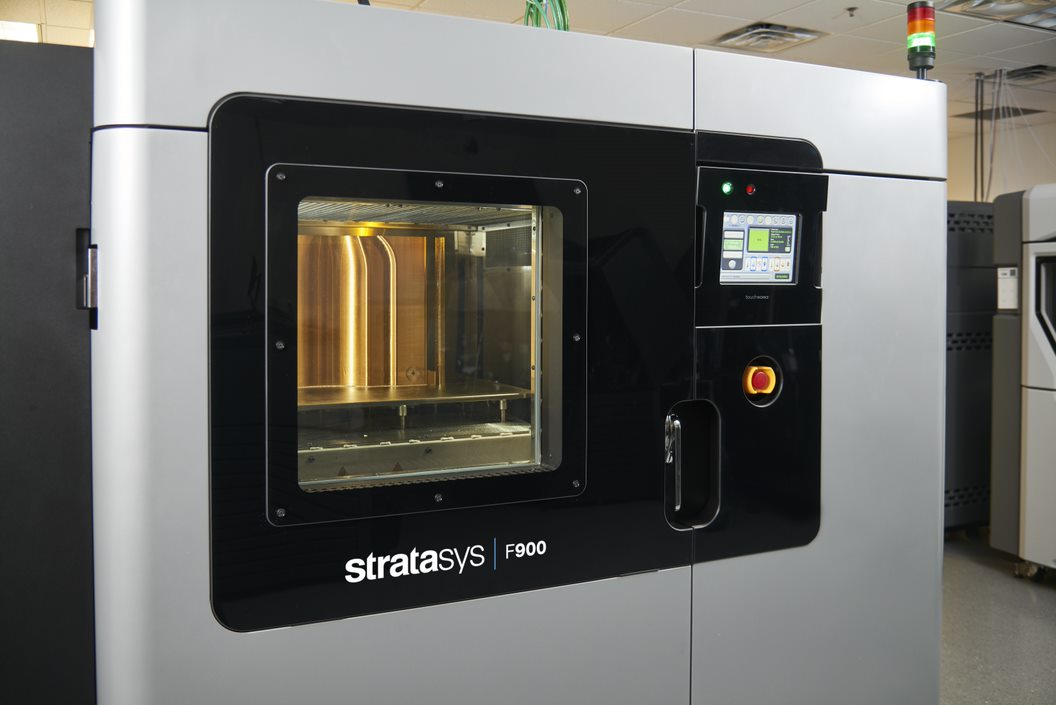
A F900 printing PEI parts for aerospace.
Stratasys F900. The Stratasys F900 is a highly capable FDM manufacturing system. If you need large parts then this is a venerable reliable system that can now print in PEKK.

Not just standalone printers HP now has the equipment you need to manufacture.
HP 5200. The HP 5200 is gaining ground and being used to produce parts at scale now. Complete with cooling units and processing station these machines are now easy to deploy for manufacturing. Part costs on 5200 machines are much lower than with other 3D printers making this a good system to make millions of unique parts with.
The post 2019 Industrial 3D Printing Buying Guide appeared first on 3DPrint.com | The Voice of 3D Printing / Additive Manufacturing.
INTERVIEW: VA Puget Sound’s Dr. Beth Ripley on advancing 3D printing in healthcare
Fraunhofer IFAM and H+E-Produktentwicklung develop 3D printed gas turbine demonstrator
Dyson V10 adapter #3DPrinting #3DThursday
This print was shared by zetif on Thingiverse! Download filed and learn more here: https://www.thingiverse.com/thing:3790184

Every Thursday is #3dthursday here at Adafruit! The DIY 3D printing community has passion and dedication for making solid objects from digital models. Recently, we have noticed electronics projects integrated with 3D printed enclosures, brackets, and sculptures, so each Thursday we celebrate and highlight these bold pioneers!
Have you considered building a 3D project around an Arduino or other microcontroller? How about printing a bracket to mount your Raspberry Pi to the back of your HD monitor? And don’t forget the countless LED projects that are possible when you are modeling your projects in 3D!
Hakko Soldering Tip Caddy #3DThursday #3DPrinting
Shared by stickyfox on Thingiverse:
Fits over the rest of Hakko soldering irons to store tips, so you don’t have to scrounge around in the junk drawer like I’ve been doing all this time.
Obviously, you should always use caution with hot things and easily-melted plastic. Please let me know if you have any heat-related problems with this part.
Download the files and learn more

Every Thursday is #3dthursday here at Adafruit! The DIY 3D printing community has passion and dedication for making solid objects from digital models. Recently, we have noticed electronics projects integrated with 3D printed enclosures, brackets, and sculptures, so each Thursday we celebrate and highlight these bold pioneers!
Have you considered building a 3D project around an Arduino or other microcontroller? How about printing a bracket to mount your Raspberry Pi to the back of your HD monitor? And don’t forget the countless LED projects that are possible when you are modeling your projects in 3D!
Raspberry Pi 4 Case with Micro SD Card Slots #3DPrinting #3DThursday

grajohnt shared this project on Thingiverse!
This is a snap-together case for the Raspberry Pi 4 with storage slots for three additional micro SD cards. This was requested by members of the Guild of Makers, and made by a member, and so it carries the guild logo.
The RPi is attached to the lower case with M2.5 screws, which should self-tap into the screw pillars.The upper case can then snaps on top. I provided plenty of room in this case for a fan (like the fan shim).

Every Thursday is #3dthursday here at Adafruit! The DIY 3D printing community has passion and dedication for making solid objects from digital models. Recently, we have noticed electronics projects integrated with 3D printed enclosures, brackets, and sculptures, so each Thursday we celebrate and highlight these bold pioneers!
Have you considered building a 3D project around an Arduino or other microcontroller? How about printing a bracket to mount your Raspberry Pi to the back of your HD monitor? And don’t forget the countless LED projects that are possible when you are modeling your projects in 3D!
Lego micro motor brackets #3DThursday #3DPrinting
Shared on Thingiverse:
I was sick and tired that the original brackets always break, are hard to get and cost around 5€ each; so I decided to make ones myself.
I optimized them for my Elegoo Mars. Might work well for all DLP Printers. I do not suppose it will work on any FDM Printer, but if I am wrong please tell me.
Download the files and learn more

Every Thursday is #3dthursday here at Adafruit! The DIY 3D printing community has passion and dedication for making solid objects from digital models. Recently, we have noticed electronics projects integrated with 3D printed enclosures, brackets, and sculptures, so each Thursday we celebrate and highlight these bold pioneers!
Have you considered building a 3D project around an Arduino or other microcontroller? How about printing a bracket to mount your Raspberry Pi to the back of your HD monitor? And don’t forget the countless LED projects that are possible when you are modeling your projects in 3D!




